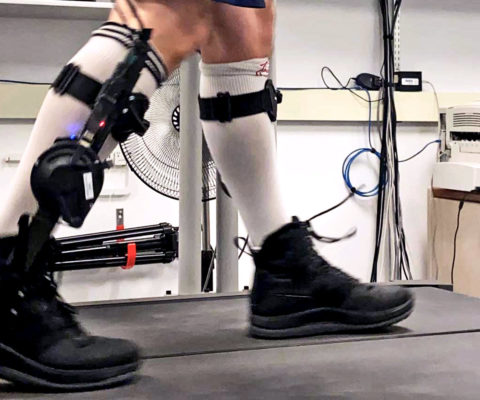A new personalized ankle exoskeleton gives users direct control to customize the device’s behavior.
To transform human mobility, exoskeletons need to interact seamlessly with their user, providing the right level of assistance at the right time to cooperate with our muscles as we move.
The new exoskeleton’s process is faster than the conventional approach, in which an expert decides the settings, and it may have incorporated preferences an expert would have missed. For instance, user height and weight, which are commonly used metrics for tuning exoskeletons and robotic prostheses, had no effect on preferred settings.
“Instead of a one-size-fits-all level of power, or using measurements of muscle activity to customize an exoskeleton’s behavior, this method uses active user feedback to shape the assistance a person receives.”
By allowing the user to directly manipulate the settings, preferences that are difficult to detect or measure could be accounted for by the users themselves. Users could quickly and independently decide what features are most important—for example, trading off comfort, power, or stability, and then selecting the settings to best match those preferences without the need for an expert to retune.
“To be able to choose and have control over how it feels is going to help with user satisfaction and adoption of these devices in the future,” Ingraham says. “No matter how much an exoskeleton helps, people won’t wear them if they are not enjoyable.”
When told to find their preference while walking on a treadmill, the set of users who had no previous experience with an exoskeleton were, on average, able to confirm their optimal settings in about one minute, 45 seconds.
In addition, user preference changed over the course of the experiment. As the first-time users gained more experience with the exoskeleton, they preferred a higher level of assistance. And, those already experienced with exoskeletons preferred a much greater level of assistance than the first-time users.
These findings could help determine how often retuning of an exoskeleton needs to be done as a user gains experience and supports the idea of incorporating direct user input into preference for the best experience.
Analysis
What I found about this article was really interesting approach in regards to Batelle’s electron sleeve. For the exoskeleton, the engineers approached the problem without the “one size fits all” approach where they tried to individualize everyone of their products to cater to the users fits and they not only make it accessible for the user to make free adjustments by themselves, it made it even quicker than if there was a second party adjusting the exoskeleton for them. This shows that rather than trying to implement changes for a user, and finding which setting work for them, it would be more efficient and also more comfortable if we make it possible for the users to be able to adjust setting themselves but also over time, their preferences may change and might need to readjust again and by making it easy to adjust, they can save time and frustration by realigning it themselves. What main thing would be, how to make it accessible and easy to adjust for users that are new to the technology or may not be attuned with modern day technology.




